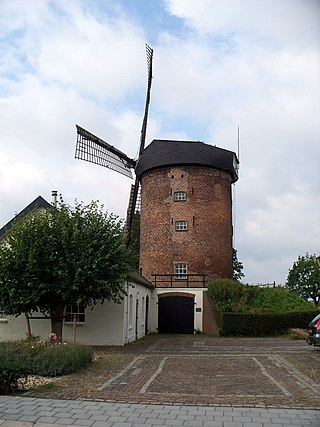
The post mill is the earliest type of European windmill. Its defining feature is that the whole body of the mill that houses the machinery is mounted on a single central vertical post. The vertical post is supported by four quarter bars. These are struts that steady the central post.

De Adriaan is a windmill in the Netherlands that burnt down in 1932 and was rebuilt in 2002. The original windmill dates from 1779 and the mill has been a distinctive part of the skyline of Haarlem for centuries.

Hazewind is a smock mill in Gieten, Drenthe, Netherlands. It was built in 1833 and has been restored to working order. The mill is listed as a Rijksmonument, number 16126.

De Gans is a smock mill in Ezumazijl, Friesland, Netherlands which has been restored to working order. The mill is listed as a Rijksmonument, number 31571.

Koffiemolen or Formerumermolen is a smock mill in Formerum, on the island of Terschelling, Friesland, Netherlands which was built in 1876 and has been restored to working order. The mill is listed as a Rijksmonument, number 35076.

De Borgmolen is a smock mill in Grou, Friesland, Netherlands which was built in 2008. Although not in full working order, it can turn in the wind. It is listed as a Rijksmonument, number 22916.

De Sweachmermolen is a smock mill between Langweer and Boornzwaag, Friesland, Netherlands which was built in 1782. The mill has two functions: it is a drainage mill and a corn mill. It has been restored to working order as a drainage mill and is listed as a Rijksmonument, number 13241.

Dutch: De Noord is a windmill located on the Noordvest 38 in Schiedam, Netherlands. It is the tallest windmill in the world with a roof height of 33.3 metres (109 ft) and a wing span of 26.6 metres (87 ft). The mill is one of the five remaining windmills in Schiedam, and has been a national monument since 29 May 1969. Today De Noord houses a restaurant.

The Oranje-Nassau Kazerne is a former military barracks in the centre of Amsterdam, along the Singelgracht canal, directly south of Artis zoo. Emperor Napoleon ordered the construction of this early 19th-century neoclassical building. Not long after construction of the building was complete in 1813, the French withdrew from the Netherlands, and the building was named in honour of the House of Orange-Nassau.

The walls of Amsterdam were built in the Middle Ages to protect the city against attack. The Medieval walls were replaced with a series of bastions in the 17th century. In the 19th century, the walls were torn down and replaced with the Defence Line of Amsterdam, a fortification line which encircled Amsterdam at a distance from the city.

De Otter is a paltrok mill in Amsterdam, Netherlands which has been restored to working order. As all Dutch paltrok mills it is a windpowered sawmill. The mill is listed as a Rijksmonument, number 1198.

De Eenhoorn is a paltrok mill in Haarlem, Netherlands which has been restored to working order. As all Dutch paltrok mills it is a windpowered sawmill. The mill is listed as a Rijksmonument, number 19872.

The Grafelijke Korenmolen van Zeddam is a tower mill in Zeddam, the Netherlands, which has been restored to working order. The mill may have been built before 1441, making it the oldest windmill in existence in the Netherlands. It is listed as Rijksmonument number 9290.

The Buitenmolen is a tower mill in Zevenaar, Netherlands that was restored to working order in 1970. The mill was built in the beginning of the sixteenth century and is listed as a Rijksmonument, number 40427.

De Akkermolen is a 17th-century windmill in Zundert, Netherlands. Built around 1605 to replace an earlier windmill, it was used as a gristmill until it was severely damaged in 1950. The mill was bought by the local government and restored in 1961, and it was listed as a national heritage site in 1974.

De Kaai is a smock mill in Sleat, Friesland, Netherlands which was built in 1755 and is in working order. The mill is listed as a Rijksmonument.

De Vrouwbuurstermolen is a smock mill in Vrouwenparochie, Friesland, Netherlands which was built in 1862 and is in working order. The mill is listed as a Rijksmonument.

De Gooyer is a smock mill in Wolvega, Friesland, Netherlands which was built in 1916. It has been restored to working order. It is listed as a Rijksmonument.

Batenburg Windmill is a post mill in Batenburg, Gelderland, Netherlands which was built in the 18th century and is under repair as of February 2014. The mill is listed as a Rijksmonument.

De Olde Molen, also known as Old Dutch Windmill, The Mill, or Alte Mühle is a non-operational octagonal smock mill with a stage reconstructed in 1961 in Bubali, Aruba. Since then, it has been serving as a restaurant and a windmill museum.























